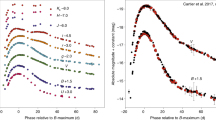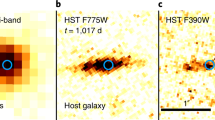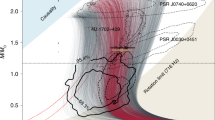Abstract
IN a previous communication1 we reported some evaluations of the neutrino energy density in the universe taking into account the e+ + e−→ ν + ν̄ process in the pre-supernova stage of the stars. We found that this energy density may be higher than the energy density of the matter. Here we present a similar evaluation on the basis of the Mannino2 hypothesis regarding the star-like objects. It is known that the optical power of these objects is about 1046–1048 ergs/sec (ref. 3). According to Mannino2, this may be due to supernova explosions of as many as 4,000 a year. During the exploding stage the temperature of the stars goes up to 109–1010° K and the star begins to emit neutrino antineutrino pairs through annihilation of electron-positron pairs which at this high temperature are in equilibrium with the photons. The neutrino emission is of the same order and even higher of the photon emission4. Thus we can safely assume that the star-like sources emit 1048 ergs/sec as neutrino power. Because the energies of these neutrinos are of the order of a MeV, we have an emission of ∼1054 ν/sec/star-like source. (We can obtain these figures also supposing that each supernova inside the star-like object emits ∼1045 ergs/sec as neutrino power; since we have 10−4 supernovse/sec, and since the process goes on for about 200 days2, this is the same as saying that at each time we have 10−4.107 = 103 supernova in the whole star-like, which means an emission of 1045.103 = 1048 ergs/sec from the star-like sources.)
This is a preview of subscription content, access via your institution
Access options
Subscribe to this journal
Receive 51 print issues and online access
$199.00 per year
only $3.90 per issue
Buy this article
- Purchase on Springer Link
- Instant access to full article PDF
Prices may be subject to local taxes which are calculated during checkout
Similar content being viewed by others
References
Boccaletti, D., de Sabbata, V., Nuovo Cimento, 33, 1216 (1964).
Mannino, G., Coelum, 32, 116 (1964).
Chiu, H. Y., Physics Today, 21 (May 1964).
Chiu, H. Y., and Stabler, R. C., Phys. Rev., 122, 1317 (1961).
Allen, C. W., Astrophysical Quantities (Athlone Press, 1963).
Author information
Authors and Affiliations
Rights and permissions
About this article
Cite this article
BOCCALETTI, D., DE SABBATA, V. & GUALDI, C. Neutrino Emission from Star-like Sources. Nature 205, 60 (1965). https://doi.org/10.1038/205060a0
Published:
Issue Date:
DOI: https://doi.org/10.1038/205060a0
This article is cited by
-
Bulletin GRG, No. 25: List of publications
General Relativity and Gravitation (1971)
Comments
By submitting a comment you agree to abide by our Terms and Community Guidelines. If you find something abusive or that does not comply with our terms or guidelines please flag it as inappropriate.



